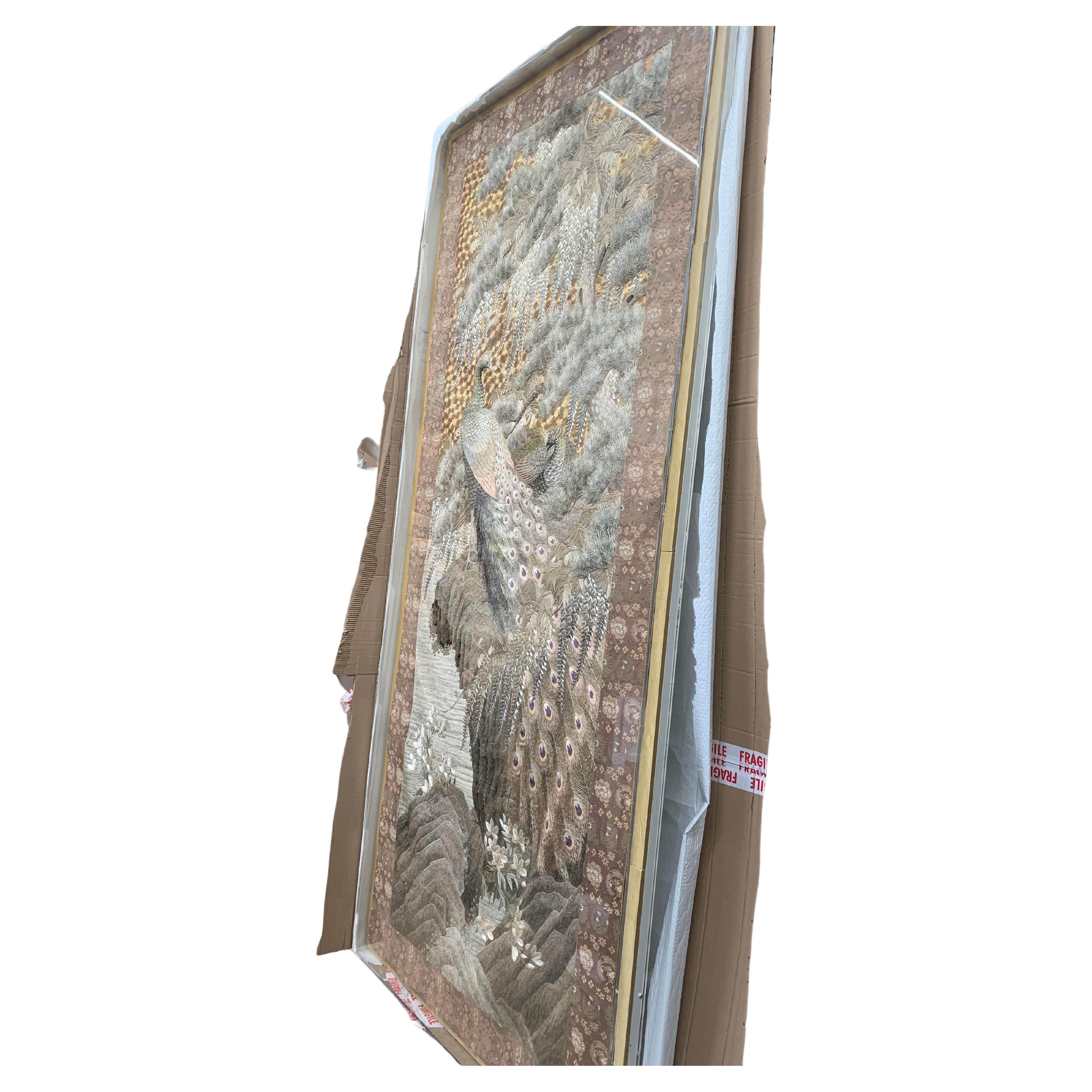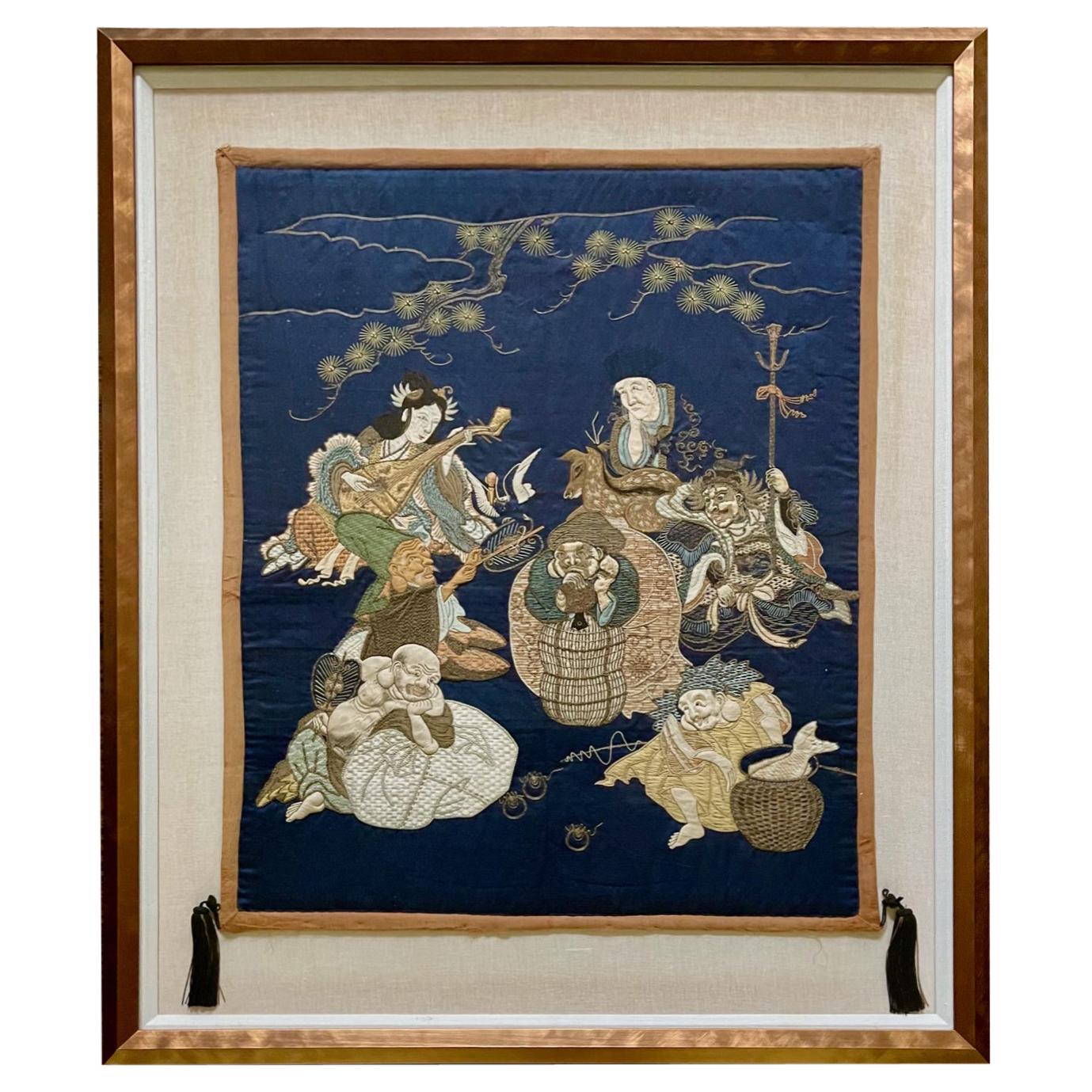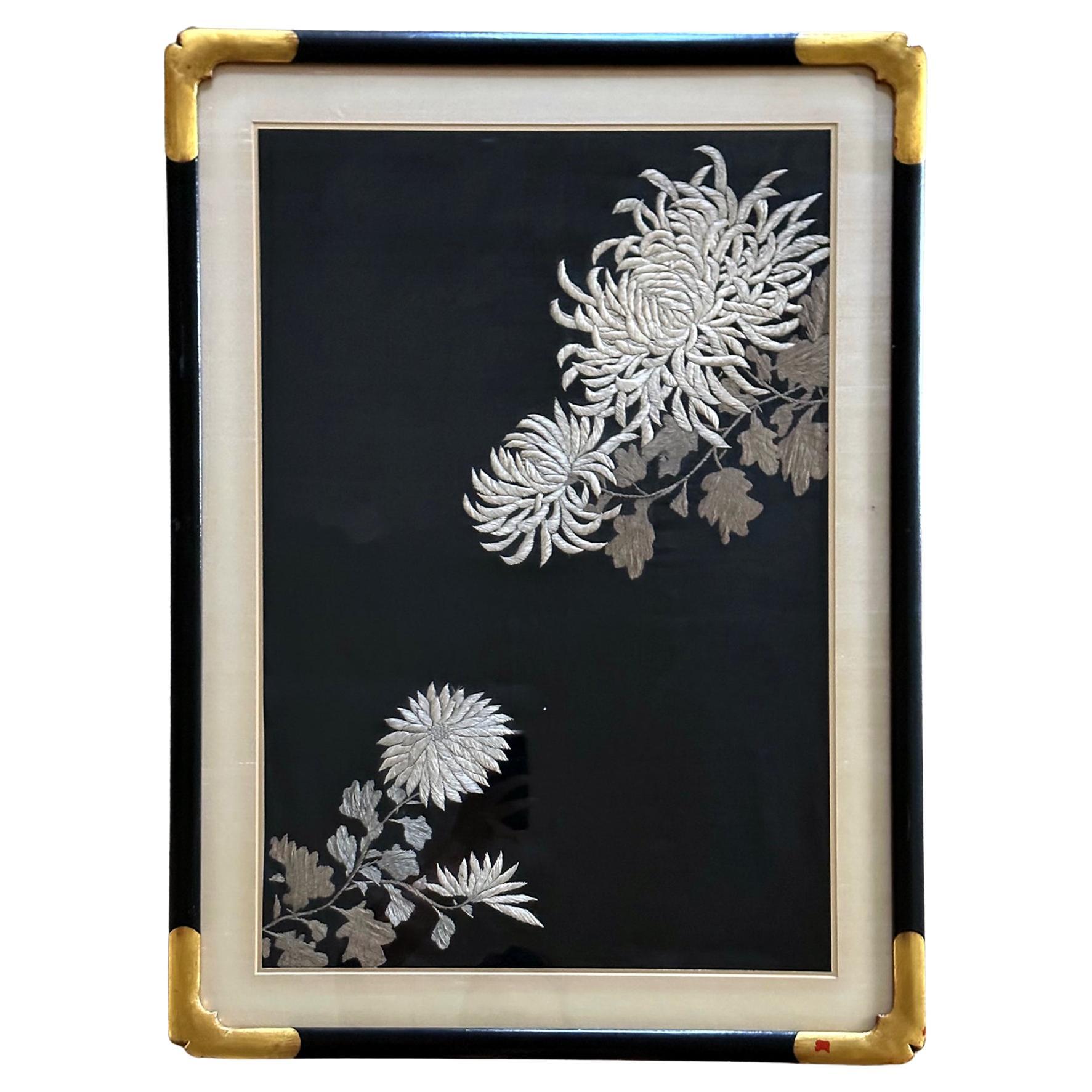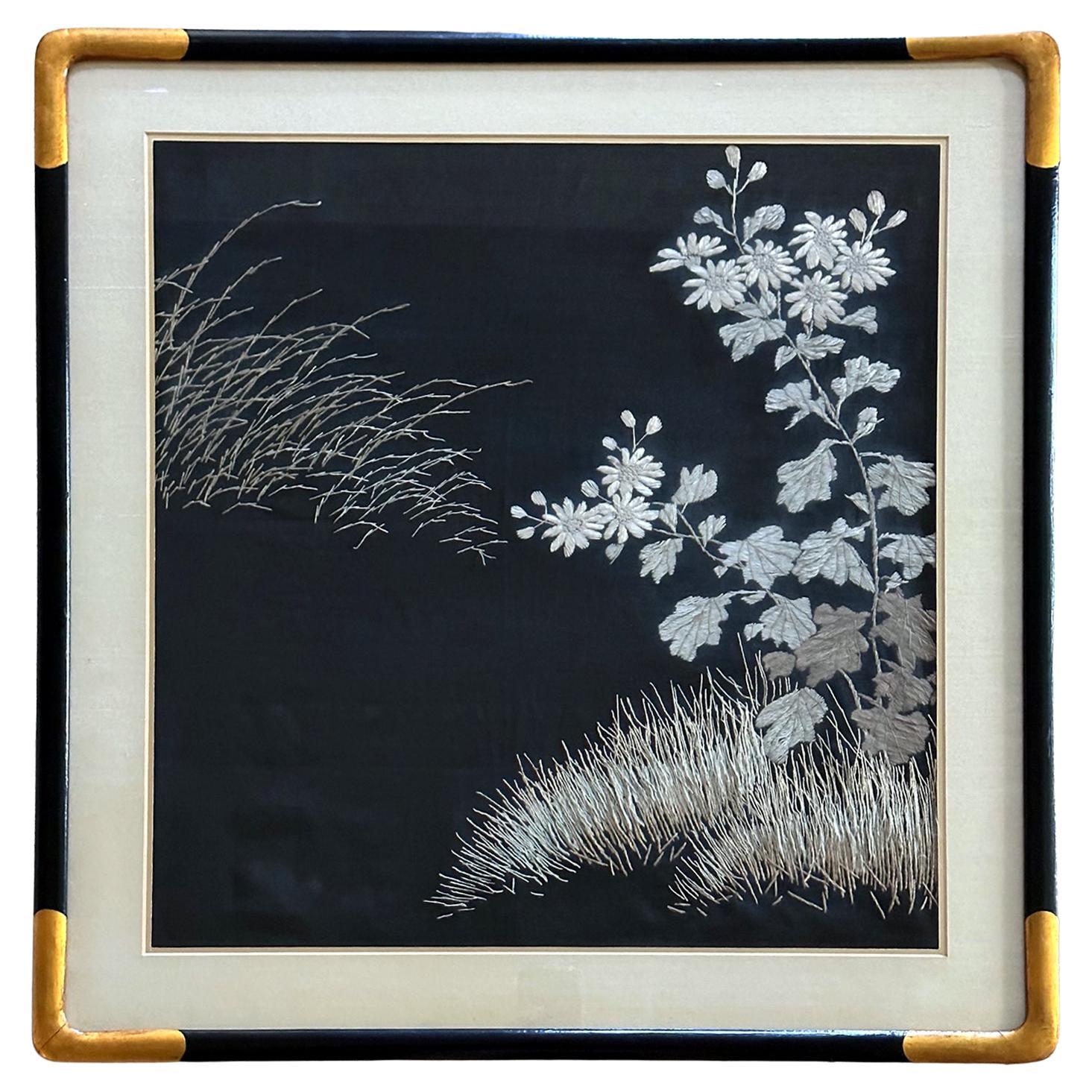Items Similar to Huge Japanese Silk Textile Goose In Flight
Want more images or videos?
Request additional images or videos from the seller
1 of 8
Huge Japanese Silk Textile Goose In Flight
About the Item
As part of our Japanese works of art collection we are delighted to offer this large scale framed Meiji Period (1868-1912) signed silk textile, the Kyoto artist has rendered a very large scale textile of a goose in flight above a lakeside setting, the vibrantly coloured goose apparently coming in to land upon a lake surrounded by finely stitched rushes and ferns, the gooses neck stretching as its eyes look for the perfect landing spot, the birds feathers and facial features beautifully hand stitched to an exacting standard of workmanship. This charming textile is signed in a large stitched seal that simply reads as”Benten Kyoto” the textile is complete within its original silk backed black lacquer glazed frame , it was not unusual for such large textiles to be removed from the frames and rolled up for easy transportation for export.
Provenance :
This large and imposing textile has been hanging in an old baronial house in the south of Germany.
Literature :
The name on the seal Benten , does not lead us to the name of a particular embroiderer and is more widely recognised as the name of the Goddess of music and arts , one of the seven lucky Gods of Japan . However further extensive research on this textile leads us to a company formed in Kyoto in 1898 by the name of Benten Goshi Kaisha, a limited partnership formed between embroidery houses and other traders, apparently partly funded by the Kyoto Hotel Group and in particular the largest hotel in Kyoto at that time The Yaamirou Hotel, commonly referred to as the Yaami, the company was set up at an initial cost of 250,000 Jpy . It is evident that our seal Benten Kyoto is representing this company.
It makes total commercial sense that the finest artisans needed exclusive access to the wealthiest tourists, and in turn the hotels could harness these tourists for longer stays and certainly more profitable visits , especially if between them they had guides working on commission bringing the visitors to the hotel, where traders selling and generally promoting the wares of Kyoto from within their building presumably worked on a profit share basis , a kind of closed shop cartel that benefited the tour guides, the hotel group, the Benten company and the Kyoto economy as a whole.
One of the best known and most powerful Kyoto based embroidery companies was the Takashimaya company, then headed up by the third generation sons Shinshichi III & IV alongside Utako, the daughter of Shinshichi I .
It is recorded in : Threads of Silk and Gold, ornamental textiles from Meiji Japan, Hiroko T. McDermott and Dr Clare Pollard Ashmolean museum Oxford , that during this turbulant period of the Meiji restoration the Takashimaya shop had burnt down, thankfully the stock was in a fireproof store and was salvaged, this enabled Shinshichi II his wife Utako and the next generation of five sons to continue trading , perhaps this fire triggered their investment into the incorporation of the Benten Goshi Kaisha company, in conjunction with the Kyoto hotel group and other selected Kyoto traders. It would certainly make commercial sense, as this would have provided the Takashimaya company with immediate access to highly desirable premises as well as to wealthy tourists, however it is also recorded in the Kyoto hotel archives that the Yaamirou hotel sadly suffered from a devastating fire on the 25th of March 1899, when it burnt to the ground. We cannot be certain of the timings or the collaboration, if any, and it is possible that these unfortunate events were years apart, and under different generations of the Shinshichi dynasty.
What we can say with a degree of certainty following further research of the Kyoto hotel group archives records, is that following this devastating fire some of the most powerful Kyoto businesses and traders submitted a business plan to the mayor of Kyoto to rebuild the Yaamirou, among the most prominent names recorded in that application was Iida Shinshichi of the Takashimaya company. By 1900, the Takashimaya which was headed by Iida Shinshichi III and IV opened its Yokohama Office in Benten Street (Benten dori).
Given this documented evidence and the plotted history of the company it seems very possible that Shinshichi III (1859-1944) was trading at the hotel as part of the Benten Goshi Kaisha company prior to that devastating fire, and certainly was instrumental in the plans to rebuild the Yaami.
As such I feel confident that this huge scale textile of such superb artistry was in fact manufactured by the house of Takashimaya, under the supervision of Iida Shinshichi III or IV in around 1898-1900.
The design work of geese in landscape was possibly by Takeuchi Seiho (1864-1942). He was in time to become one of the most respected Nihonga genre painters based in Kyoto, like Watanabe Seitei (1851-1918), Mochizuki Gyokuzan (1834-1913) and others who often painted swimming ducks and flying geese. Takeuchi Seiho was appointed as a chief designer for the Takashimaya in 1889.
Condition report :
Very fine condition with minimal signs of staining or fading.
Approximate Sizes :
Overall Height : 82 1/2″ 210 cm
Overall Width : 61 1/2″ 156 cm
Textile Height : 66″ 168 cm
Textile Width : 43 3/4″ ” 111 cm
Free UK delivery and a certificate of authenticity are included in the price of this item.
* Overseas buyers please enquire for shipping *
- Dimensions:Height: 82.5 in (209.55 cm)Width: 61.5 in (156.21 cm)Depth: 2.75 in (6.99 cm)
- Style:Meiji (Of the Period)
- Materials and Techniques:
- Place of Origin:
- Period:
- Date of Manufacture:1868-1912
- Condition:Wear consistent with age and use.
- Seller Location:Christchurch, GB
- Reference Number:1stDibs: LU8622236869212
About the Seller
5.0
Vetted Seller
These experienced sellers undergo a comprehensive evaluation by our team of in-house experts.
Established in 2011
1stDibs seller since 2023
Typical response time: 1 hour
- ShippingRetrieving quote...Ships From: Christchurch, United Kingdom
- Return PolicyA return for this item may be initiated within 14 days of delivery.
More From This SellerView All
- Monumental Japanese Silk Textile - Peacocks in Landscape.By TakashimayaLocated in Christchurch, GBAs part of our Japanese works of art collection we are delighted to offer this outstanding large scale Meiji Period 1868-1912 silk textile depicting a pair of peacocks within a lands...Category
Antique Late 19th Century Japanese Meiji Textiles
MaterialsGold
- Japanese Silk Textile by Iida Takashimaya CompanyBy TakashimayaLocated in Christchurch, GBAs part of our Japanese works of art collection we are delighted to offer this charming Meiji period 1868-1912 embroidery of a chin dog aside a spray of peacock feathers and by one of the most famous textile company’s of the period, the Iida Takashimaya company, the breathtaking and simply captivating detail of the silkwork demonstrates some of the finest possible stitching methods available at that time and not surpassed to this day, the silk picture is cushioned and housed within its original black lacquered wood frame and importantly bearing the original and scarce Iida Takashimaya factory label to the reverse, an absolute masterpiece from a golden period of textile production, this picture would light up the wall of any room particularly your Japanese themed space . Provenance : UK Collection . Featured in – 2020 Vision of an enlightened ruler exhibition – plate 39 Literature : There is little doubt that a major part of the phenomenon of Japanese works of art exploding onto the worldwide stage leading up to and during the Meiji period was bought about by the Textile manufacturers of Kyoto, the most recognized of which will undoubtedly be the Nishimura company, founded in Kyoto in 1670 as textile traders, It was the 12th generation manager Nishimura Sozayemon (1855-1935) aged just 17 and remarkably adopted into the family as the son of a Chinese scholar who took the company to its dizzy heights. As early as 1873 just one year into his tenure the company were exhibiting at expositions and even during that early period the company picked up significant awards and medals with recognition both nationally and overseas , particularly in Paris in 1878 , thereafter the factory moved to new premises in Kyoto , presumably having outgrown their original site , this move coincided with the building of the new Imperial palace in Tokyo where Nishimura were commissioned to provide 64 embroidered wall panels...Category
Early 20th Century Japanese Meiji Textiles
MaterialsSilk
- Captivating Japanese Bronze Goose Jardiniere by SeiyaLocated in Christchurch, GBAs part of our Japanese works of art collection we are delighted to offer this most captivating large Meiji Period 1868-1912 bronze plant holder/ jardiniere, cast at the foundry of t...Category
Antique 19th Century Japanese Meiji Metalwork
MaterialsBronze
- Huge Japanese Silver and Mixed Metal Bowl by Miyamoto ShokoLocated in Christchurch, GBAs part of our Japanese works of art collection we are delighted to offer this large and stylish Meiji Period 1868-1912, circa 1900 solid silver and mixed metal bowl by the renowned ...Category
Antique 19th Century Japanese Meiji Metalwork
MaterialsMetal, Silver
- Huge 17th century Japanese Arita Imari ChargerBy AritaLocated in Christchurch, GBAs part of our Japanese works of art collection we are delighted to offer this outstanding condition Edo Period 1612-1868, circa 17oo , very large Imari palette dish or charger, manu...Category
Antique 18th Century Japanese Edo Ceramics
MaterialsCeramic
- Enchanting Japanese Bronze Owl OkimonoLocated in Christchurch, GBAs part of our Japanese works of art collection we are delighted to offer this most enchanting Meiji Period (1868-1912), bronze okimono depicting a long eared owl upon a rootwood bra...Category
Antique Late 19th Century Japanese Meiji Metalwork
MaterialsBronze
You May Also Like
- Framed Antique Japanese Silk Embroidery Fukusa Textile PanelLocated in Atlanta, GAA Japanese Fukusa Panel with tassels displayed in a gilt frame circa Meiji Period. Fukusa is a traditional Japanese textile art used as a...Category
Antique Late 19th Century Japanese Meiji Textiles
MaterialsSilk, Wood
- Japanese Asian Framed Meiji Peroid Silk Floral Flower Embroidery Textile PanelLocated in Studio City, CAA beautiful and wonderfully designed/composed Japanese textile panel with embroidery floral natural landscape/flower decoration. The work is pr...Category
Antique 19th Century Japanese Meiji Textiles
MaterialsTextile, Silk, Wood
- Framed Japanese Embroidery Textile Panel Meiji PeriodLocated in Atlanta, GAA Japanese textile panel with embroidered picture work circa late Meiji period (1900s) presented in a gilt wood frame with silk mat. The work de...Category
Antique Early 1900s Japanese Meiji Textiles
MaterialsSilk, Wood
- Framed Japanese Embroidery Textile Panel Meiji PeriodLocated in Atlanta, GAA Japanese textile panel with embroidery needlework circa late Meiji period (1900s) presented in a gilt wood frame with silk mat. The work depic...Category
Antique Early 1900s Japanese Meiji Textiles
MaterialsSilk, Wood
- Framed Antique Japanese Embroidery Fukusa Textile PanelLocated in Atlanta, GAA Japanese silk Fukusa Panel housed in a gilt frame circa late 19th century of Meiji Period. Fukusa is a traditional Japanese textile art used as a wrap for presenting gifts at important occasions. On the deep blue background, the elaborate embroidery work depicts a historical scene where street vendors selling goods to a royal household or an aristocratic residence. The scene focuses on the activities at the front gate where the couriers and servants were busying carrying the goods in. A peasant with straw coat...Category
Antique Late 19th Century Japanese Meiji Textiles
MaterialsSilk, Wood
- Framed Antique Japanese Embroidery Fukusa Textile PanelLocated in Atlanta, GAA Japanese silk Fukusa Panel housed in a gilt frame circa late 19th century of Meiji Period. Fukusa is a traditional Japanese textile art used as a wrap for presenting gifts at important occasions. On the deep blue background, the elaborate embroidery work depicts three deities of the Shichifukujin (Seven Gods of Fortune...Category
Antique Late 19th Century Japanese Meiji Textiles
MaterialsSilk, Wood
Recently Viewed
View AllMore Ways To Browse
Takashimaya Embroidery
Flying Goose
Japanese Silk Landscape
Silk Prayer Mat
Antique Buttons Asian
Yazd Textile
Japan Noren
Ayat Al Kursi
Hand Embroidered Bed Spreads
Suzani Spread
Ottoman Robe
Vintage Childrens Decor
Vintage Long Robe Brocade
Floral Embroidered Bed Spread
Takashimaya Embroidery
1940 Japanese Wedding Kimono
Chinese Bamboo Jacket
Framed Chinese Embroidery Panel Of Longevity Deities





